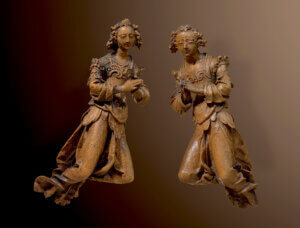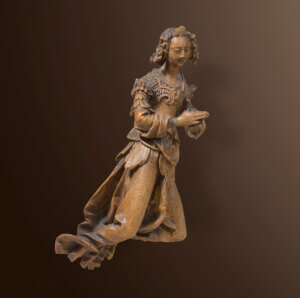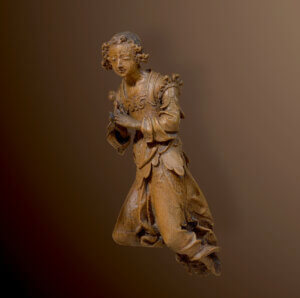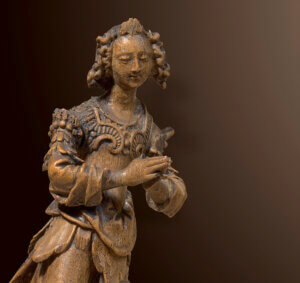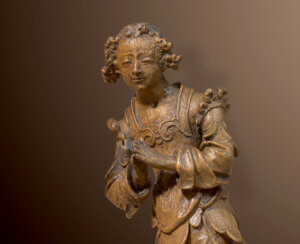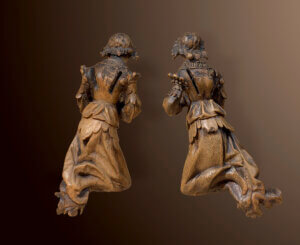These two figures are a pair of flying angels made around 1500 in the province of Brabant in Flanders. They are carved from oak wood and have dimensions 38-40 cm. The angels can be attributed to the circle of Jan Borman the Elder, an important Flemish carving master of the late Gothic period or the Dutch Renaissance, who was active in Brussels between 1479 and 1520. He was the founder of a Brabant sculptor dynasty and joined a sculptor’s guild in Brussels in 1479. The reference work of this sculptor family is considered to be the Saint George retable for the chapel Onze-Lieve-Vrouw van Ginderbuyten in Leuven, which he possibly executed together with his son Jan Bormann the Younger in 1493. In 1511 he was also commissioned to make wooden models for the tombs for the Duke and Duchess of Brabant.
The angels are shown in elongated-manicured, moving form; the bent legs and swirled robe reveal that the angels are probably in flight. The slits of the separately carved and later attached wings are clearly visible on the backs of the full-round figures. Particularly impressive is the richly decorated clothing with variously decorated tops with ornate textile surfaces. Typical for carvings from Brabant are here also the long, tubular folds of the drapery. Particularly characteristic, however, are the short, almost weightless, luxuriant locks of hair, parted at the center parting and ending in two small curls above the forehead. This expression is comparable to a figure in the Arenberg Lament of 1470-80 (Detroit Institute of Arts, inv. no. 61,164) or the candelabra angels of about 1500 (Detroit Institute of Arts, inv. no. 25,18-19). Other comparative examples are in the Cleveland Museum of Art (inv. no. 1948.475) and in a 2019 Sotheby’s auction (lot 21), the latter figure of an angel having a similar head of hair as well as the same slit-like openings on the back where originally attached wings must have been. However, the angels presented here are far more richly decorated, as is often seen in the carvings of Jan Borman. His style is particularly associated with carefully carved decorative details of contemporary costumes and elaborate hair, as well as dynamic poses.
The level-headed faces with almond-shaped eyes, straight noses and small mouths are turned downward, probably looking down at the viewer. The faces, which seem almost individual, testify to a lifelike expression of expressive piety, which is emphasized by the hands folded in prayer. Through this, the heavenly creatures show the believers what attitude they should take. Since the 15. century the demand for altars for private devotion increased, it could be here figures of an altar for a representative house chapel. Very related in this context is from the Brussels carved altar from the beginning of the 16th century from the Museum Schnütgen in Cologne. This is an extremely rare opportunity to acquire a work from the circle of this important dynasty of sculptors and at the same time two figures in museum quality execution of the Dutch Renaissance.
https://www.dia.org/art/collection/object/lamentation-64850
https://www.dia.org/art/collection/object/angel-holding-candlestick-25064
https://www.dia.org/art/collection/object/angel-holding-candlestick-25065
https://www.clevelandart.org/art/1948.475
https://museenkoeln.de/portal/bild-der-woche.aspx?bdw=2002_10
